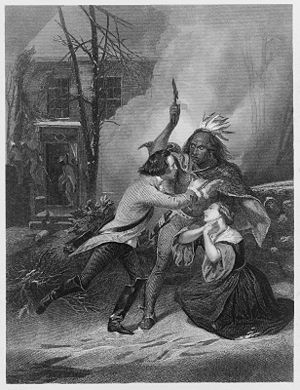Cherry Valley massacre
| Cherry Valley massacre | |||||||
|---|---|---|---|---|---|---|---|
| Part of the American Revolutionary War | |||||||
 Cherry Valley massacre, the fate of Jane Wells, one of thirty non-combatants killed during the massacre. |
|||||||
|
|||||||
| Belligerents | |||||||
|
|
Seneca tribe Mohawk |
||||||
| Commanders and leaders | |||||||
|
Ichabod Alden † William Stacy (POW) |
Walter Butler Cornplanter Joseph Brant Little Beard |
||||||
| Strength | |||||||
|
7th Massachusetts Regiment 250 settlers and militia |
321 Iroquois 150 Butler's Rangers 50 8th Regiment of Foot |
||||||
| Casualties and losses | |||||||
| 14 soldiers killed 11 soldiers captured 30 inhabitants killed 30 inhabitants taken into captivity |
5 wounded | ||||||
The Cherry Valley massacre was an attack by British and Iroquois forces on a fort and the village of Cherry Valley in eastern New York on November 11, 1778, during the American Revolutionary War. It has been described as one of the most horrific frontier massacres of the war. A mixed force of Loyalists, British soldiers, Seneca and Mohawks descended on Cherry Valley, whose defenders, despite warnings, were unprepared for the attack. During the raid, the Seneca in particular targeted non-combatants, and reports state that 30 such individuals were slain, in addition to a number of armed defenders.
The raiders were under the overall command of Walter Butler, who exercised little authority over the Indians on the expedition. Historian Barbara Graymont describes Butler's command of the expedition as "criminally incompetent". The Seneca were angered by accusations that they had committed atrocities at the Battle of Wyoming, and the colonists' recent destruction of their forward bases of operation at Unadilla, Onaquaga, and Tioga. Butler's authority with the Indians was undermined by his poor treatment of Joseph Brant, the leader of the Mohawks. Butler repeatedly maintained, against accusations that he permitted the atrocities to take place, that he was powerless to restrain the Seneca.
During the campaigns of 1778, Brant achieved an undeserved reputation for brutality. He was not present at Wyoming, although many thought he was, and actively sought to minimize the atrocities that took place at Cherry Valley. The massacre contributed to calls for reprisals, leading to the 1779 Sullivan Expedition which drove the Iroquois out of western New York.
...
Wikipedia
